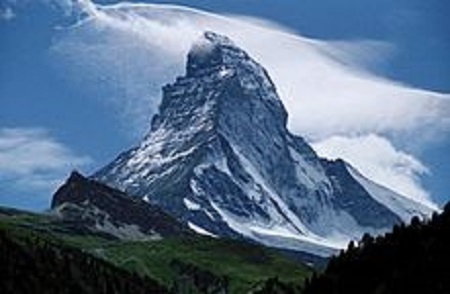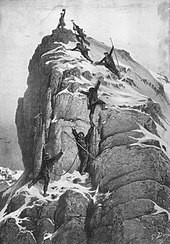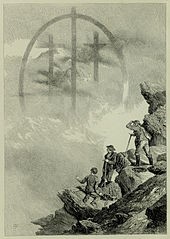First Ascent of The MATTERHORN
Grades 4+
In the summer of 1860, Edward Whymper, an athletic twenty-year-old British artist, visits the Alps for the first time. He has been hired by a London publisher to make sketches and engravings of the Alps. Soon interested in mountaineering, he decides to attempt the yet unconquered Matterhorn.
There is a rival. Jean-Antoine Carrel, an Italian guide, has been attempting to be the first to reach the summit for three years.
Whymper tries climbing the mountain several times. In 1865, weary of defeats, he tries the east face, but he and his team are met by an avalanche of stone. His guides refuse to make any further attempts by this route.

The Matterhorn from Zermatt
Whymper wants to head to the mountain again, but he can find no porters to help him haul equipment up the mountain. He then runs into an Englishman, Lord Francis Douglas, who has a porter and agrees to go with Whymper to try the ascent. At the hotel, they run into three other mountaineers: Michel Croz, Charles Hudson, and Douglas Hadow. They hire two local guides, Peter Taugwalder and his son. They agree to start the next day.

The first ascent of the Matterhorn by Gustave Doré
Instead of being an extremely difficult climb, the east slope proves astonishingly easy. It rises for 3,000 feet like a huge natural staircase. Not once are they brought to a halt by any serious obstacle. In fact, there is no need for being roped together.
They take a break at 12,800 feet and again at 14,00, having arrived at the foot of the much steeper upper peak, where they rope up. Overcoming a ridge, they see that only two hundred feet of easy snow remain, Croz and Whymper unrope and run to the top.
The race is a dead heat.
No footsteps are in the snow. They are the first to climb the magnificent mountain.
They see the Italian expedition, led by Carrel, far below. They roll rocks down and get the Italian’s attention. The Italian team turns back toward the mountain’s base, since the mountain has been conquered. They knew Whymper was going to attempt the mountain, but they had considered his intended route impossible.
Whymper and his party stay on the summit for an hour. Then they begin their descent. Croz first, first, then Hadow, Hudson and Douglas, Taugwalder senior, Whymper with Taugwalder junior coming last. They climb down with care, one man moving at a time.
When they are barely an hour from the summit and all are on the same rope, Hadow slips and falls on Croz. Unprepared and unable to withstand the shock, Croz also falls. Their weight pulls down Hudson and Douglas. Croz shouts, “Impossible!”
The first ascent of the Matterhorn by Gustave Doré


Falling. by Whympe
The shout reaches Whymper and the Taugwalders. They clasp rocks. They are safe, but the rope breaks. Four men slide down the slope, trying with convulsive hands to stop themselves. They hit rock after rock but are unable to stop.
They disappear over the edge, a fall of 4,000 feet.
Whymper and the other climbers return to climbing down. They are in shock.
A curious weather phenomenon of an arch and two crosses (later determined as a fog bow by Whymper) forms above them. They find a resting place at 9.30 p.m. and resume the descent at daybreak.
Searchers discover the bodies of Croz, Hadow, and Hudson. Douglas’s body is never found.
The surviving climbers later discover the descent was undertaken with the oldest and weakest rope. It was never meant to be used. It was only intended as a reserve.
Fog-bow seen from the Matterhorn by Whympe

Matterhorn Activity 1
Identify the determiners in the following:
⦁ His guides refuse to make any further attempts by this route.
⦁ No footsteps are in the snow.
⦁ They climb down with care, one man moving at a time.
⦁ Douglas’s body is never found.
⦁ A curious weather phenomenon of an arch and two crosses (later determined as a ⦁ fog bow by Whymper) forms above them.